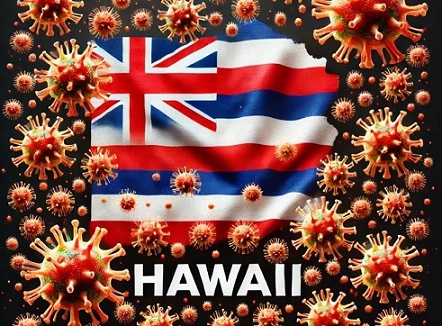Nikhil Prasad Fact checked by:Thailand Medical News Team Jul 24, 2024 1 year, 4 months, 2 weeks, 1 day, 18 hours, 59 minutes ago
U.S. Medical News:
Rising Positivity Rates and Alarming Wastewater Findings
Hawaii is experiencing a significant surge in COVID-19 cases, with the state's positivity rate reaching a concerning 16.3 percent.
 Hawaii's COVID-19 positivity rate soars amid wastewater concerns
Hawaii's COVID-19 positivity rate soars amid wastewater concerns
Image: Generated by AI
Adding to the worry, the Centers for Disease Control and Prevention (CDC) has reported "very high" levels of SARS-CoV-2, the virus responsible for COVID-19, in Hawaii's wastewater.
The recent data positions Hawaii among 21 states where the COVID-19 virus presence in local sewage is alarmingly high. This uptick has prompted the CDC to express serious concerns about the spread of the virus in these regions.
Despite rising COVID-19 infections along with hospitalizations and even a slight rise in COVID-19 deaths nationwide, most of the mainstream media in the United States are not covering any
U.S. Medical News coverages to warn the public about the rising infections, hence most Americans are oblivious to the rising threat.
https://www.thailandmedical.news/news/most-americans-oblivious-that-covid-19-is-now-surging-in-45-states-of-which-26-have-high-infections-levels
Worse, many ignorant individuals are assuming that COVID-19 infections are comparable to mild flu infections and that they have nothing to worry about. There has been so much misinformation by health authorities and even medical experts that use terms to describe that the current variants are ‘mild’ without having any real scientific evidence to prove that these variants do not cause any long term health issues! Hundreds of peer reviewed studies have validated that exposure to the SARS-CoV-2 virus irrespective of being asymptomatic or mildly symptomatic during initial infection, can still result in many serious long term health issues.
Current COVID-19 Statistics in Hawaii
As of July 17, Hawaii reported a weekly count of 937 COVID-19 cases. This results in a 7-day daily average of 135 cases. These figures reflect a substantial increase in transmission, contributing to the overall heightened state of alert in the region. The COVID-19 test positivity rate was recorded at 16.3 percent for the that period.
https://health.hawaii.gov/coronavirusdisease2019/
The National Context: Rising Wastewater COVID Levels
Hawaii's situation is part of a broader national trend. For the second consecutive week, COVID-19 levels in wastewater across the United States have been elevated.
https://www.cdc
.gov/nwss/rv/COVID19-statetrend.html
This trend is largely driven by the emergence of the “FLuQE” subvariants ie the KP3 sub-lineages including KP.3.1.1, which the CDC estimates to account for most of the new cases nationally.
Understanding Wastewater Viral Activity Levels
The CDC categorizes Wastewater Viral Activity Levels into five distinct categories:
Minimal: Less than 1.5
Low: Greater than 1.5 and up to 3
Moderate: Greater than 3 and up to 4.5
High: Greater than 4.5 and up to 8
Very High: Greater than 8
Hawaii, along with 20 other states, falls into the "very high" category, indicating significant viral activity and potential for widespread transmission.
https://www.cdc.gov/nwss/rv/COVID19-currentlevels.html
Other Affected States
Besides Hawaii, other western states showing very high levels of COVID-19 in wastewater include Alaska, California, Oregon, Washington, Idaho, New Mexico, Texas, Utah, and Wyoming. Nationally, the states experiencing similar levels of concern include Colorado, Connecticut, Florida, Louisiana, Maryland, Minnesota, Nevada, New Hampshire, North Carolina, Vermont, West Virginia, and Washington, D.C.
California's Alarming Situation
California's wastewater data reveals coronavirus levels exceeding last summer’s peak. This is a strong indicator of the rapid spread of the new KP3 sub-lineages. With California now classified among the 21 states with "very high" levels, nearly half of America’s population - about 155 million people -are residing in areas with significant viral presence in sewage.
Implications and Public Health Response
The surge in COVID-19 positivity rates and the concerning findings in wastewater signal a potential public health crisis. The high levels of the virus in sewage suggest widespread community transmission, necessitating enhanced public health measures and vigilant monitoring.
The CDC's findings underscore the importance of continued vigilance and adherence to preventive measures. Public health officials are likely to intensify efforts to mitigate the spread of the virus, including promoting vaccination, encouraging the use of masks in high-risk settings, and maintaining robust testing and contact tracing systems.
Conclusion
Hawaii's escalating COVID-19 positivity rate and the alarming levels of the virus in wastewater are clear indicators of the challenges ahead. As the state navigates this surge, it remains crucial for the public to stay informed, adhere to health guidelines, and support community efforts to curb the spread of COVID-19. The situation serves as a stark reminder of the virus's persistent threat and the need for ongoing vigilance in the fight against the pandemic.
For the latest
U.S. Medical News, keep on logging to Thailand Medical News.
Read Also:
https://www.thailandmedical.news/news/covid-19-positivity-rates-in-california-reaches-12-8-percent
https://www.thailandmedical.news/news/covid-19-infections-now-hitting-new-records-in-netherlands
